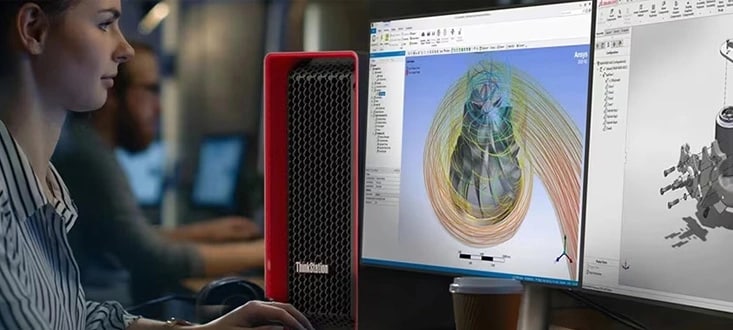-
Shop Lenovo Store
|
-

 Join a Community
Join a Community -

 Contact Us
Contact Us -

 Account
Account -

 Cart
Cart
Intel Core desktop processors (14th Gen)
Gamers, content creators, and multi-taskers looking for a new PC can find a lot to love in Intel® Core™ desktop processors (14th Gen). They expand Intel’s recent move to offer specialized performance and efficiency cores within each chip, delivering raw speed—or workhorse production—when you need it.
Compared to the previous generation, you’ll find faster boost frequencies across all 14th Gen Intel® Core™ desktop CPUs, including up to 6.0 GHz in the Core i9 line for enthusiasts.1 The performance-focused Core i7 line, meanwhile, offers a higher maximum core count than before, among other updates.
MORE FROM INTEL
Beyond raw power, faster DDR-5 memory is supported on all processors in the 14th Gen Intel® Core™ desktop family. The Core i7 chips offer larger gaming-friendly L3 caches than earlier models. And all Intel® Core™ desktop processors (14th Gen) are overclockable,2 with select models that include a new AI Assist feature to help you set it up.
Intel® Core™ desktop processors (14th Gen) were announced in late 2023, and Intel officially unveiled the chips at the 2024 Consumer Electronics Show (CES). Manufacturers such as Lenovo quickly offered multiple new desktop PCs powered by 14th Gen chips, including office, workstation, and gaming systems. Keep reading to learn more.
Speedier 'Performance' cores, additional 'Efficient' cores
Intel’s performance hybrid processor architecture1 is now well-known, and Intel® Core™ desktop processors (14th Gen) take things a step further—boosting turbo speeds on the family’s fastest Performance cores (P-cores) and adding more Efficient cores (E-cores) to the mid-range offering. For gamers, this means smoother gameplay and more wins. For creators and multi-taskers, it means improved multi-threaded performance to get more done.
Not familiar with Intel’s hybrid-core CPUs? It’s an innovation that puts two kinds of cores on the same processor. Demanding workloads designed to work on speedy single threads, such as many video games, go to the P-cores, which are bigger and faster but draw more power (and create more heat). Less critical tasks—or chores that can be easily shared across multiple cores and threads—are sent to the smaller, cooler-running E-cores, which outnumber the P-cores and are more energy-efficient.
- For gamers and high-end PC enthusiasts, the top-of-the-line 14th Gen Intel® Core™ i9-14900K processor, boasts a maximum Turbo Boost frequency of 6.0 GHz (up from 5.8 GHz in the previous generation).4
- For multi-taskers—this includes you, content creators-- the mid-range Intel® Core™ i7-14700K offers 25% more cores than previous-gen Core i7 CPUs—now up to 20 cores and 28 threads.
Whether your PC runs on a 14th Gen Intel® Core™ i9, Core i7 or Core i5 processor, all the P-core and E-core wizardry is managed by Intel® Thread Director. It’s built-in, and constantly monitors real-time performance data to intelligently distribute your application threads to the cores that can handle them best—at the moment you send your task.5
14th Gen Intel Core desktop processors: Specifications
Table 1 offers a high-level look at Intel® Core™ desktop processors (14th Gen). Note that the maximum specifications shown here may not be available from every PC maker, such as Lenovo, because not all companies build systems with every possible CPU. Be sure to review the specs of any PCs you're considering.
Table 1: Announced specifications of Intel® Core™ desktop processors (14th Gen)
|
14th Gen Intel® Core™ i9 (Desktop) |
14th Gen Intel® Core™ i7 (Desktop) |
14th Gen Intel® Core™ i5 (Desktop) |
14th Gen Intel® Core™ i3 (Desktop) |
Turbo Frequency |
Up to 6.0 GHz |
Up to 5.6 GHz |
Up to 5.3 GHz |
Up to 4.7 GHz |
Intel® Turbo Boost Max 3.0 Frequency |
Up to 5.8 GHz |
Up to 5.6 GHz |
Not available |
Not available |
Performance-Core Max Turbo Frequency6 |
Up to 5.6 GHz |
Up to 5.5 GHz |
Up to 5.1 GHz |
Up to 4.7 GHz |
Efficient-Core Max Turbo Frequency |
Up to 4.4 GHz |
Up to 4.3 GHz |
Up to 3.9 GHz |
Not available |
Processor Cores (P-cores + E-cores)7 |
24 (8P+16E) |
20 (8P+12E) |
14 (6P+8E) |
4 (4P+0E) |
Processor Threads |
32 |
28 |
20 |
8 |
Intel® Hyper-Threading |
Yes |
Yes |
Yes |
Yes |
Intel® Thread Director5 |
Yes |
No |
||
Intel® Smart Cache (L3) |
36 MB |
33 MB |
24 MB |
12 MB |
Total L2 Cache |
32 MB |
28 MB |
20 MB |
5 MB |
P-core/ E-core / Graphics / Memory Overclocking |
Yes |
No |
||
Max Memory Speed8 |
Up to DDR5-5600 |
DDR5 4800 |
||
Memory Channels |
2 |
|||
CPU PCIe 5.0 Lanes13 |
Up to 16 |
|||
CPU PCIe 4.0 Lanes |
4 |
|||
What’s new in 14th Gen Intel Core desktop processors?
Many PC users prize desktop models for the extra power and performance that can be packed into their larger form factor. And likewise, Intel has packed a lot of advances into its 14th Gen desktop CPUs.
Here’s what’s new in Intel® Core™ desktop processors (14th Gen):
- More processing power: 14th Gen Intel® Core™ processors are a stop above earlier versions, delivering faster boost speeds across the line-up and a more productivity-enhancing cores and threads on some models. It’s the third release of desktop chips built on Intel’s innovative performance hybrid core architecture (see details above).
- Smoother gameplay: Compared to the previous generation, Intel® Core™ i7 desktop (14th Gen) configurations deliver more L2 and L3 cache, a kind of performance-enhancing memory that further accelerates processing. For gamers, in particular, this can mean higher, more consistent FPS rates and smoother on-screen action.
- Faster memory: With the latest release, every chip in the 14th Gen Intel® Core™ desktop processor family supports speedy DDR5 memory (up to 5600 MT/s), along with the DDR4 memory (up to 3200 MT/s) supported earlier.8 System configurations will differ by manufacturer, but now, users have a choice.
- Overclocking with an AI twist: Every Intel® Core™ desktop processor (14th Gen) is overclockable, so you can squeeze-out a few more hertz when you need it. And on some 14th Gen chips, the Intel® Extreme Tuning Utility—a tool used to set up and monitor overclocking—has a new AI Assist feature to help find the best settings based on how you use your PC.
- Speedy connectivity: All Intel desktop CPUs support WiFi 6 and WiFi 6E and 14th Gen Intel® Core™ desktop CPUs offer native support for WiFi 7,9 which can offer dramatically higher Gbps throughput with compatible components and networks. This enables PC manufacturers to include WiFi 7-based components in 14th Gen-powered desktops, if they choose to do so (configurations will vary).
In addition, 14th Gen Intel® Core™ desktop processors are compatible with both the Intel® 600 series and Intel® 700 series chipsets, ensuring lightning-fast communication across the motherboard—CPU, GPU (if equipped), RAM and other components. Here again, manufacturer configurations will vary.
Intel Core desktop processors (14th Gen): Additional features
We’ve covered the expanded P-core and E-core architecture, additional L3 cache allotments, faster memory support and other performance advances in 14th Gen Intel® Core™ desktop processors. But there’s much more that makes these advanced CPUs so special.
Table 2 describes some of the additional noteworthy features of 14th Gen Intel® Core™ desktop processors.
Table 2 : Additional noteworthy features of Intel® Core™ desktop processors (14th Gen)
FEATURE |
BENEFIT |
PCIe 5.013 up to 16 Lanes |
Enables transfer speeds up to 32 GT/s for accessing graphics, storage, and peripherals (up to 16 PCI Express 5.0 lanes). |
PCIe 4.0 up to 4 Lanes |
Enables transfer speeds up to 16 GT/s (up to 4 PCI Express 4.0 lanes). |
Intel® Deep Learning Boost |
Speeds-up AI inference to enhance performance for deep learning workloads. |
Intel® Adaptive Boost Technology (ABT)4,10 |
Increases performance by dynamically enabling higher multi-core turbo frequencies when current, power, and thermal headroom exists. |
Intel® Turbo Boost Max Technology 3.01 |
Monitors processor cores and directs critical workloads to the fastest available. |
Intel® UHD Graphics driven by Intel® Xe Architecture11 |
Delivers rich media and intelligent graphics capabilities that enable amplified visual complexity and enhanced 3D performance. |
Intel® Dynamic Memory Boost12 |
Intelligent memory overclocking performance on-demand that optimizes platform performance based on usage. |
Like we said at the start, there’s a lot to like in 14th Gen Intel CPUs for desktop PCs, whether you’re looking for extra boost power, more cores and threads, faster memory support, or new overclocking capabilities and tools. And you’ll find Intel® Core™ desktop processors (14th Gen) across Lenovo’s strong desktop PC line-up... from ThinkCentre systems to ThinkStation workstations to Legion gaming rigs. Which one is for you?
NOTE: These 14th Gen Intel® Core™ desktop processors were preceded by other models, including 13th Gen Intel® Core™ desktop processors.
Intel, the Intel logo, Intel Evo, Intel Core, and Intel vPro are trademarks of Intel Corporation or its subsidiaries.
1 Intel® Hyper-Threading Technology, Intel® Turbo Boost Max Technology 3.0, and Intel® Thermal Velocity Boost are only available on Performance-cores.
2 Unlocked features are present with select chipsets and processor combinations. Altering clock frequency or voltage may void any product warranties and reduce stability, security, performance, and life of the processor and other components. Check with system and component manufacturers for details.
3 Performance hybrid architecture combines two core microarchitectures, Performance-cores (P-cores) and Efficient-cores (E-cores), on a single processor die first introduced on 12th Gen Intel® Core™ processors. Select 12th Gen and newer Intel® Core™ processors do not have performance hybrid architecture, only P-cores or E-cores, and may have the same cache size. See ark.intel.com for SKU details, including cache size and core frequency.
4 Intel® Hyper-Threading Technology, Intel® Turbo Boost Max Technology 3.0, and Intel® Thermal Velocity Boost are only available on Performance-cores.
5 Built into the hardware, Intel® Thread Director is provided only in performance hybrid architecture configurations of 12th Gen or newer Intel® Core™ processors; OS enablement is required. Available features and functionality vary by OS.
6 Intel® Thermal Velocity Boost: Only available on Intel® Core™ i7 processors (14th gen HX-series) and Intel® Core™ i9 processors (14th gen HX-series). For more information on Intel® TVB refer to https://www.intel.com/content/www/us/en/gaming/resources/how-intel-technologies-boost-cpu-performance.html?wapkw=thermal velocity boost
7 P-cores + E-cores: Processor cores listed first are the total number of cores in the processor. The number of Performance-cores and the number of Efficient-cores are listed in parentheses (P+E).
8 Memory Speed: Maximum memory speeds are associated with 1 DIMM per Channel (1DPC) configurations. Additional DIMM loading on any channel may impact maximum memory speed. Up to DDR5-5600 MT/s 1DPC UDIMM 1Rx8, 1Rx16 and DDR5-5200 1Rx8, 1Rx16, 2Rx8 on select SKUs. Maximum memory capacity is achievable with 2DPC configurations. For additional 2DPC configuration details, see ark.intel.com for SKU details.
9 Subject to network availability, operating system support, and router compatibility. Visit www.intel.com/performance-wireless for more details.
10 Intel® Core™ i9 desktop processors (14th gen) only.
11 Available only on Intel® Core™ processors (14th gen) featuring integrated graphics.
12 Intel® Dynamic Memory Boost enablement capability requires BIOS selection of the feature, a compatible Intel® Core™ desktop processor, a compatible motherboard with BIOS support for the feature, and XMP certified DDR4 or DDR5 main system memory.
13 Minimum solution requirements, mandatory certification, and a 40 Gbps connection which provides the fastest connection as compared to other PC client bidirectional I/O connection technologies like eSATA and USB. Must be connection via Thunderbolt(TM) 3 or newer accessory to enable full performance. See www.intel.con/PerformanceIndex (connectivity) for details. Results may vary.




